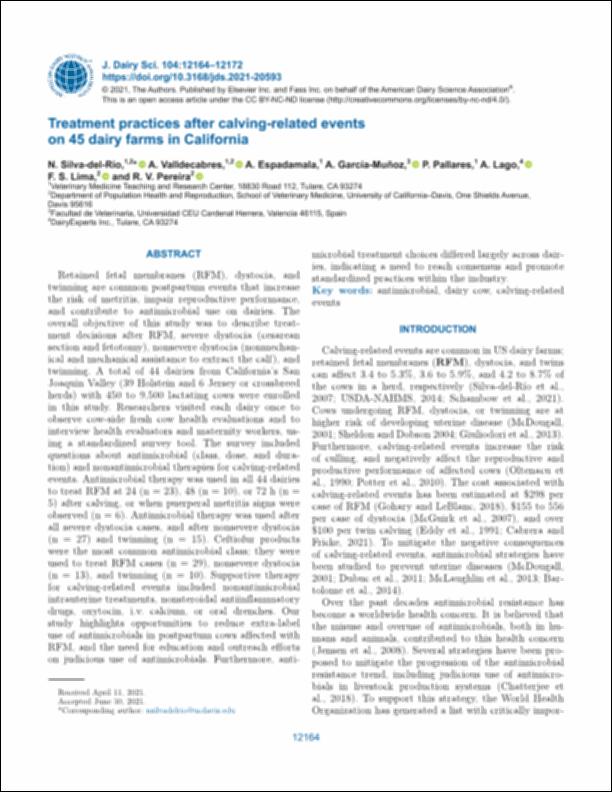Please use this identifier to cite or link to this item:
http://hdl.handle.net/10637/13542Treatment practices after calving-related events on 45 dairy farms in California
| Title: | Treatment practices after calving-related events on 45 dairy farms in California |
| Authors : | Silva del Río, Noelia Valldecabres Inchaustegui, Ainhoa Espadamala, Arnau García Muñoz, Ángel Pallares, P. Lago, Alfonso Lima, Fabio S. Pereira, Richard V. |
| Keywords: | Labor (Obstetrics) - Complications - Treatment.; Ganado vacuno lechero - Parto.; Antiinfecciosos en veterinaria.; Parto - Complicaciones y secuelas - Tratamiento.; Anti-infective agents in veterinary medicine.; Dairy cattle - Parturition. |
| Publisher: | Elsevier |
| Citation: | Silva-Del-Río, N., Valldecabres, A., Espadamala, A., García-Muñoz, A., Pallares, P., Lago, A., Lima, F. S. & Pereira, R. V. (2021). Treatment practices after calving-related events on 45 dairy farms in California. Journal of Dairy Science, vol. 104, i. 11 (nov.), pp. 12164–12172. DOI: https://doi.org/10.3168/jds.2021-20593 |
| Abstract: | Retained fetal membranes (RFM), dystocia, and twinning are common postpartum events that increase the risk of metritis, impair reproductive performance, and contribute to antimicrobial use on dairies. The overall objective of this study was to describe treatment decisions after RFM, severe dystocia (cesarean section and fetotomy), nonsevere dystocia (nonmechanical and mechanical assistance to extract the calf), and twinning. A total of 44 dairies from California’s San Joaquin Valley (39 Holstein and 6 Jersey or crossbreed herds) with 450 to 9,500 lactating cows were enrolled in this study. Researchers visited each dairy once to observe cow-side fresh cow health evaluations and to interview health evaluators and maternity workers, using a standardized survey tool. The survey included questions about antimicrobial (class, dose, and duration) and nonantimicrobial therapies for calving-related events. Antimicrobial therapy was used in all 44 dairies to treat RFM at 24 (n = 23), 48 (n = 10), or 72 h (n = 5) after calving, or when puerperal metritis signs were observed (n = 6). Antimicrobial therapy was used after all severe dystocia cases, and after nonsevere dystocia (n = 27) and twinning (n = 15). Ceftiofur products were the most common antimicrobial class; they were used to treat RFM cases (n = 29), nonsevere dystocia (n = 13), and twinning (n = 10). Supportive therapy for calving-related events included nonantimicrobial intrauterine treatments, nonsteroidal antiinflammatory drugs, oxytocin, i.v. calcium, or oral drenches. Our study highlights opportunities to reduce extra-label use of antimicrobials in postpartum cows affected with RFM, and the need for education and outreach efforts on judicious use of antimicrobials. Furthermore, antimicrobial treatment choices differed largely across dairies, indicating a need to reach consensus and promote standardized practices within the industry. |
| Description: | Este artículo se encuentra disponible en la siguiente URL: https://www.sciencedirect.com/science/article/pii/S0022030221008584?via%3Dihub |
| URI: | http://hdl.handle.net/10637/13542 |
| Rights : | http://creativecommons.org/licenses/by-nc-nd/4.0/deed.es |
| ISSN: | 0022-0302 1525-3198 (Electrónico) |
| Issue Date: | 23-Nov-2021 |
| Center : | Universidad Cardenal Herrera-CEU |
| Appears in Collections: | Dpto. Producción y Sanidad Animal, Salud Pública Veterinaria y Ciencia y Tecnología de los Alimentos |
Items in DSpace are protected by copyright, with all rights reserved, unless otherwise indicated.


